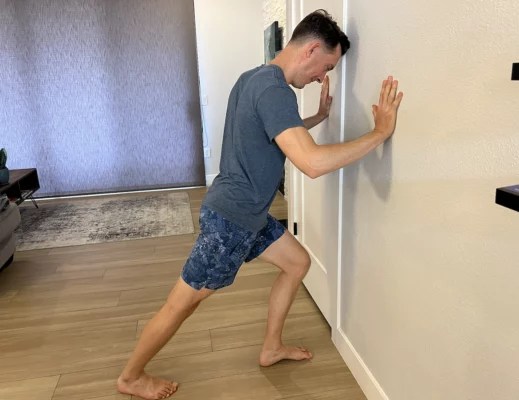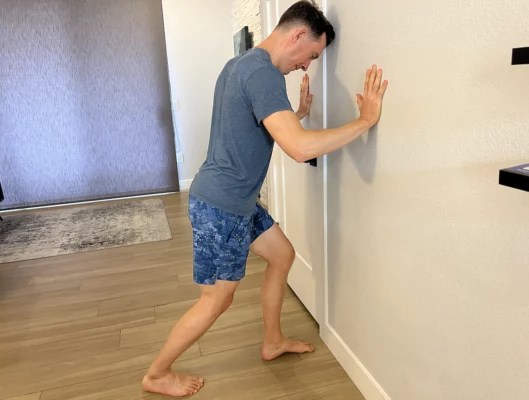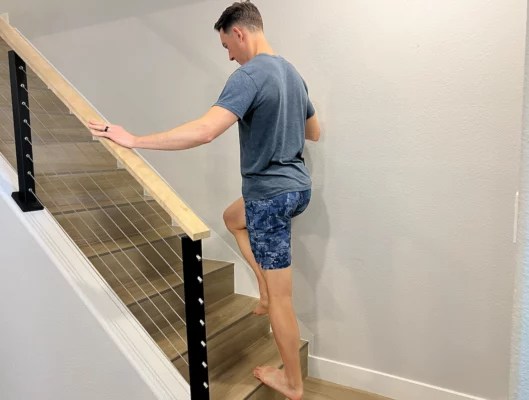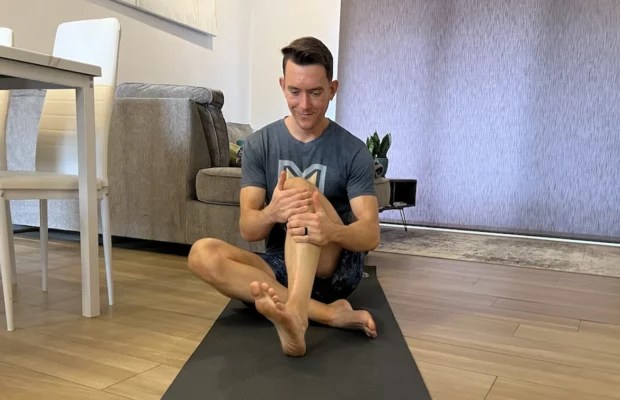If you have tight calves, you know lower-leg pain and movement restriction can make everything from doing a squat to descending a flight of stairs seemingly impossible. You may have tried stretching and foam rolling with limited success, or taken a massage gun to your calves only to find that, within a day or so, you’re right back to where you started: walking like Frankenstein.
Don’t worry: You’re not destined to hobble around in discomfort forever, and you don’t have to settle for squats that never break parallel. There’s a right way to stretch tight calves that leads to longer-lasting relief and improved movement patterns.
For expert advice and guidance, we called upon physical therapists Grayson Wickham, PT, DPT, founder of Movement Vault and Hilary Granat, PT, DPT, owner of C.O.R.E. Physical Therapy. They shared their thoughts on why your calves may be seizing up and the best calf stretch exercises you can do for that long-awaited relief.
Which muscles make up your calves?
The two primary muscles that make up the calf are the gastrocnemius and the soleus. The gastrocnemius originates at two different points of the femur (thigh bone) behind your knee. It travels down the back side of your lower leg where, along with the soleus, it attaches to the Achilles tendon, which inserts into the back of the heel. Originating at the top of the tibia (shin bone), the soleus runs beneath the gastrocnemius.
The gastrocnemius is the bulkier muscle of the two and gives your calf its distinctive shape. Together, the gastrocnemius and the soleus drive plantar flexion, the ankle movement that points your toes down and away from your shin (think about your foot pressing down on a gas pedal). On its own, the gastrocnemius also acts as a knee flexor.
What causes tight calves, anyway?
Inactivity can contribute to tight or immobile calves, according to Dr. Wickham.
“We sit way too much and have a lack of varied movement,” he says, explaining that your body will adapt to anything you do (and don’t do). “If your ankle seldom uses its full range of motion, your body is going to adapt to that and eventually get tight.”
And even if you do exercise regularly, you may still lack mobility.
“Running only uses a limited range of motion. Doing a lunge only uses a limited range of motion,” he says. “Unfortunately, I see people that have been working out for decades, and they do plenty of leg exercises and calf raises, but they still have tight ankles.”
Dr. Wickham notes that delayed onset muscle soreness (DOMS) can feel like tightness, but it’s caused by the muscle damage that occurs during a new or tougher-than-usual workout. If your calves are constantly sore, you may be overtraining.
“Training too much and not recovering enough can lead to calf muscle tightness and cramping,” Dr. Granat says.
It’s also important to stay on top of your fluid intake, she adds, as dehydration and electrolyte imbalance can also contribute to calf cramping.
The best calf muscle stretches to relieve tightness
Each of the following best stretches, demonstrated by Dr. Wickham, employs a technique called active (aka “dynamic”) stretching. So, rather than relaxing into a stretch or allowing gravity to do the work (aka “passive” or “static” stretching), you actively contract a muscle once it’s fully stretched.
Active stretching exercises not only improve flexibility and mobility but also bolster joint strength and stability, muscle activation, and proprioception (body awareness), Dr. Wickham explains.
1. Active gastrocnemius stretch

- Stand facing a wall with your feet hip-width apart.
- Place your hands on the wall for support and step your right foot behind you.
- Bend your left knee and straighten your right leg, pressing your right heel against the ground.
- Once you feel a deep stretch in your lower right leg, contract your calf muscle by pushing the ball of your foot into the ground, like you’re pushing down on a gas pedal.
- Hold the contraction for 10 to 20 seconds, then release it.
- Next, contract the muscles on the front of your ankle by pulling up on your foot, like you’re taking your foot off the gas pedal.
- Hold the contraction for 10 to 20 seconds, then release it.
- Repeat the sequence 3 to 4 times, then switch legs.
2. Active soleus stretch

- Stand facing a wall with your feet hip-width apart.
- Place your hands on the wall for support and step your right foot behind you.
- Bend your left knee and push your right heel against the ground, allowing a slight bend in your right knee.
- Once you feel a deep stretch in your lower right leg, contract your calf muscle by pushing the ball of your foot into the ground, like you’re pushing down on a gas pedal.
- Hold the contraction for 10 to 20 seconds, then release it.
- Next, contract the muscles on the front of your ankle by pulling up on the foot, like you’re taking your foot off the gas pedal.
- Hold the contraction for 10 to 20 seconds, then release it.
- Repeat the sequence 3 to 4 times, then switch legs.
3. Half-kneeling calf stretch

- Begin in a half-kneeling position with your left knee bent at 90 degrees and your left foot flat on the ground.
- Place your right knee on the ground on top of a mat or cushion.
- Keeping your left heel on the ground, drive your left knee forward over your toes until you feel a stretch in your left calf and the back of your left ankle.
- Contract your left calf muscle by pushing the ball of your foot into the ground, like you’re pushing down on a gas pedal.
- Hold the contraction for 10 to 20 seconds, then release it.
- Next, contract the muscles on the front of your ankle by pulling up on the foot, like you’re taking your foot off the gas pedal.
- Hold the contraction for 10 to 20 seconds, then release it.
- Repeat the sequence 3 to 4 times, then switch legs.
4. Negative calf raise

- Stand on the edge of a step or box so that both heels are hanging over the edge.
- Holding onto a railing or stable structure for support, lift your right leg so that you’re balancing on your left foot. (To make this movement easier, keep both feet on the step.)
- Perform a calf raise on your left leg by pushing through the ball of your left foot and lifting your heel as high as possible.
- Next, count to 10 as you slowly lower your heel as far as you can. You should feel a deep stretch in the working calf.
- Repeat until your calf muscle fatigues (usually 5 to 20 reps), then switch legs.
5. Controlled ankle circle

- From a seated, cross-legged position, extend your left leg in front of you. Bend your left knee and place both hands on your shin. (This keeps your knee from moving from side to side.)
- Slowly rotate your ankle in a clockwise direction. Engage your calf muscles as you focus on moving through your ankle’s full range of motion.
- Perform 5 to 10 ankle circles, then reverse direction to do 5 to 10 circles counter-clockwise.
- Switch legs and repeat.
FAQ
1. How long should you stretch tight calves?
Dr. Wickham recommends spending at least 10 minutes on active stretching three times a week. These sessions should include the calves as well as all the other areas of the body.
“Any tight muscles or unstable joints are weak links in your kinetic chain that could lead to joint compensation that leads to pain and injury down the line,” he says.
Someone with very tight calves may want to increase their total amount of time stretching so they can spend more time focusing on the calves and ankles.
2. Can massage loosen tight calves?
A traditional massage will feel good, but it won’t have a lasting effect on tight calves. However, self-myofascial release (SMR), aka “foam rolling,” can send messages to the nervous system to decrease muscle tone, causing tightness.
Dr. Wickham recommends applying pressure to any tender spots while slowly flexing and pointing your foot rather than just rolling up and down your calf.
3. My calves still feel tight after stretching. What should I do?
Calf pain, cramping, and tightness that doesn’t go away could indicate other health concerns, like poor circulation or nerve compression, according to Dr. Granat.
“Sciatica or a pinched nerve in the back can cause calf muscle tightness and cramps,” she says.
Other potential causes include postural issues, like leaning too far forward and hyperextending your knees, and biomechanical problems in your feet.
“Overpronation of the foot, when the foot rolls in too much or flattens, can put a repetitive strain on your calf, which will lead to tightness. Also, if the foot is not strong enough, it can lead to calf problems,” she says.
So, if active stretching isn’t helping your tight calves, make an appointment with your doctor or physical therapist.
